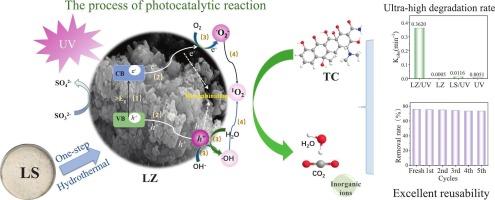一步水热法合成锂渣基沸石超快光催化降解四环素
IF 4.7
3区 化学
Q2 CHEMISTRY, PHYSICAL
Journal of Photochemistry and Photobiology A-chemistry
Pub Date : 2025-09-13
DOI:10.1016/j.jphotochem.2025.116783
引用次数: 0
摘要
本研究采用一步水热法将锂渣(LS)转化为沸石光催化剂(LZ),实现了四环素(TC)的超快紫外光催化降解。LZ对TC的吸附量(20.35%)比LS(2.51%)显著提高了17.84%,这是由于LZ比表面积更大,增加了约42.29 m2/g。在365 nm紫外光下,LZ在3 min内的降解率为68.35%,降解速率常数为0.3620 min−1,分别比LZ和UV高46.95 ~ 64.69% (0.3569 ~ 0.3615 min−1)。其基本机理归因于•O₂−/h+为主氧化,显著提高了光电分离效率。此外,LZ/UV体系也表现出稳定的光催化能力和较高的实用性。该光催化剂有望用于生活污水处理,为废物资源化利用提供可持续、高效的解决方案。本文章由计算机程序翻译,如有差异,请以英文原文为准。

One-step hydrothermal synthesis of lithium slag-based zeolite for the ultrafast photocatalytic degradation of tetracycline
This study converted lithium slag (LS) into a zeolite photocatalyst (LZ) via a one-step hydrothermal method, achieving the ultrafast ultraviolet (UV) photocatalytic degradation of tetracycline (TC). The TC adsorption capacity of LZ (20.35 %) was significantly enhanced by 17.84 % compared to that of LS (2.51 %), which was attributed to a more extensive specific surface area, which increased by approximately 42.29 m2/g. The LZ displayed a degradation rate of 68.35 % within 3 min at UV light of 365 nm and a high rate constant of 0.3620 min−1, which was 46.95–64.69 % (0.3569–0.3615 min−1) higher than LZ or UV alone, respectively. The underlying mechanism was attributed to •O₂−/h+-dominated oxidation and significantly enhanced photoelectric separation efficiency. In addition, the LZ/UV system also demonstrated stable photocatalytic capacity and high practicality. This photocatalyst shows promise for domestic sewage treatment, providing a sustainable, efficient solution for waste resource utilization.
求助全文
通过发布文献求助,成功后即可免费获取论文全文。
去求助
来源期刊
CiteScore
7.90
自引率
7.00%
发文量
580
审稿时长
48 days
期刊介绍:
JPPA publishes the results of fundamental studies on all aspects of chemical phenomena induced by interactions between light and molecules/matter of all kinds.
All systems capable of being described at the molecular or integrated multimolecular level are appropriate for the journal. This includes all molecular chemical species as well as biomolecular, supramolecular, polymer and other macromolecular systems, as well as solid state photochemistry. In addition, the journal publishes studies of semiconductor and other photoactive organic and inorganic materials, photocatalysis (organic, inorganic, supramolecular and superconductor).
The scope includes condensed and gas phase photochemistry, as well as synchrotron radiation chemistry. A broad range of processes and techniques in photochemistry are covered such as light induced energy, electron and proton transfer; nonlinear photochemical behavior; mechanistic investigation of photochemical reactions and identification of the products of photochemical reactions; quantum yield determinations and measurements of rate constants for primary and secondary photochemical processes; steady-state and time-resolved emission, ultrafast spectroscopic methods, single molecule spectroscopy, time resolved X-ray diffraction, luminescence microscopy, and scattering spectroscopy applied to photochemistry. Papers in emerging and applied areas such as luminescent sensors, electroluminescence, solar energy conversion, atmospheric photochemistry, environmental remediation, and related photocatalytic chemistry are also welcome.

 求助内容:
求助内容: 应助结果提醒方式:
应助结果提醒方式:


